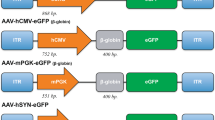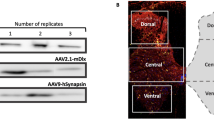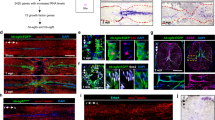Abstract
The identification of axon growth-promoting genes, and overexpression of these genes in central nervous system (CNS) neurons projecting to the spinal cord, has emerged as one potential approach to enhancing CNS regeneration. Assessment of the regenerative potential of candidate genes usually requires axonal tracing of spinal projections, ideally limited to neurons that express the candidate gene. Alternatively, coexpression of a reporter gene such as enhanced green fluorescent protein (GFP) from an internal ribosomal entry site can be used to identify neurons expressing the candidate gene, but this strategy does not label corticospinal axons in the spinal cord. We therefore developed a dual promoter lentiviral vector in which a potentially therapeutic transgene is expressed from the cytomegalovirus-enhanced chicken β-actin promoter and the fluorescent protein copGFP is expressed from the elongation factor-1α promoter. The vector was constructed to be compatible with the Gateway recombination system for efficient introduction of transgenes through entry shuttle vectors. We show both simultaneous expression of a candidate and reporter gene in corticospinal and red nucleus neurons, and efficient labeling of their axons after lesions in the cervical spinal cord. This expression system is therefore an accurate and efficient means of screening candidate genes in vivo for enhancement of axonal growth.
This is a preview of subscription content, access via your institution
Access options
Subscribe to this journal
Receive 12 print issues and online access
$259.00 per year
only $21.58 per issue
Buy this article
- Purchase on Springer Link
- Instant access to full article PDF
Prices may be subject to local taxes which are calculated during checkout







Similar content being viewed by others
References
Blesch A, Tuszynski MH . Cellular GDNF delivery promotes growth of motor and dorsal column sensory axons after partial and complete spinal cord transections and induces remyelination. J Comp Neurol 2003; 467: 403–417.
Grill R, Murai K, Blesch A, Gage FH, Tuszynski MH . Cellular delivery of neurotrophin-3 promotes corticospinal axonal growth and partial functional recovery after spinal cord injury. J Neurosci 1997; 17: 5560–5572.
Widenfalk J, Lundstromer K, Jubran M, Brene S, Olson L . Neurotrophic factors and receptors in the immature and adult spinal cord after mechanical injury or kainic acid. J Neurosci 2001; 21: 3457–3475.
Lu P, Jones LL, Tuszynski MH . BDNF-expressing marrow stromal cells support extensive axonal growth at sites of spinal cord injury. Exp Neurol 2005; 191: 344–360.
Grimpe B, Silver J . A novel DNA enzyme reduces glycosaminoglycan chains in the glial scar and allows microtransplanted dorsal root ganglia axons to regenerate beyond lesions in the spinal cord. J Neurosci 2004; 24: 1393–1397.
Cafferty WB, Yang SH, Duffy PJ, Li S, Strittmatter SM . Functional axonal regeneration through astrocytic scar genetically modified to digest chondroitin sulfate proteoglycans. J Neurosci 2007; 27: 2176–2185.
Jones LL, Margolis RU, Tuszynski MH . The chondroitin sulfate proteoglycans neurocan, brevican, phosphacan, and versican are differentially regulated following spinal cord injury. Exp Neurol 2003; 182: 399–411.
Jones LL, Sajed D, Tuszynski MH . Axonal regeneration through regions of chondroitin sulfate proteoglycan deposition after spinal cord injury: a balance of permissiveness and inhibition. J Neurosci 2003; 23: 9276–9288.
Bradbury EJ, Moon LD, Popat RJ, King VR, Bennett GS, Patel PN et al. Chondroitinase ABC promotes functional recovery after spinal cord injury. Nature 2002; 416: 636–640.
Davies SJ, Fitch MT, Memberg SP, Hall AK, Raisman G, Silver J . Regeneration of adult axons in white matter tracts of the central nervous system. Nature 1997; 390: 680–683.
Properzi F, Carulli D, Asher RA, Muir E, Camargo LM, van Kuppevelt TH et al. Chondroitin 6-sulphate synthesis is up-regulated in injured CNS, induced by injury-related cytokines and enhanced in axon-growth inhibitory glia. Eur J Neurosci 2005; 21: 378–390.
McKerracher L, David S, Jackson DL, Kottis V, Dunn RJ, Braun PE . Identification of myelin-associated glycoprotein as a major myelin-derived inhibitor of neurite growth. Neuron 1994; 13: 805–811.
Mukhopadhyay G, Doherty P, Walsh FS, Crocker PR, Filbin MT . A novel role for myelin-associated glycoprotein as an inhibitor of axonal regeneration. Neuron 1994; 13: 757–767.
Chen MS, Huber AB, van der Haar ME, Frank M, Schnell L, Spillmann AA et al. Nogo-A is a myelin-associated neurite outgrowth inhibitor and an antigen for monoclonal antibody IN-1. Nature 2000; 403: 434–439.
GrandPre T, Nakamura F, Vartanian T, Strittmatter SM . Identification of the Nogo inhibitor of axon regeneration as a Reticulon protein. Nature 2000; 403: 439–444.
Wang KC, Koprivica V, Kim JA, Sivasankaran R, Guo Y, Neve RL et al. Oligodendrocyte-myelin glycoprotein is a Nogo receptor ligand that inhibits neurite outgrowth. Nature 2002; 417: 941–944.
Schwab JM, Conrad S, Monnier PP, Julien S, Mueller BK, Schluesener HJ . Spinal cord injury-induced lesional expression of the repulsive guidance molecule (RGM). Eur J Neurosci 2005; 21: 1569–1576.
Hata K, Fujitani M, Yasuda Y, Doya H, Saito T, Yamagishi S et al. RGMa inhibition promotes axonal growth and recovery after spinal cord injury. J Cell Biol 2006; 173: 47–58.
Low K, Culbertson M, Bradke F, Tessier-Lavigne M, Tuszynski MH . Netrin-1 is a novel myelin-associated inhibitor to axon growth. J Neurosci 2008; 28: 1099–1108.
Manitt C, Colicos MA, Thompson KM, Rousselle E, Peterson AC, Kennedy TE . Widespread expression of netrin-1 by neurons and oligodendrocytes in the adult mammalian spinal cord. J Neurosci 2001; 21: 3911–3922.
Schmitt AB, Breuer S, Liman J, Buss A, Schlangen C, Pech K et al. Identification of regeneration-associated genes after central and peripheral nerve injury in the adult rat. BMC Neurosci 2003; 4: 8.
Neumann S, Woolf CJ . Regeneration of dorsal column fibers into and beyond the lesion site following adult spinal cord injury. Neuron 1999; 23: 83–91.
Tanabe K, Bonilla I, Winkles JA, Strittmatter SM . Fibroblast growth factor-inducible-14 is induced in axotomized neurons and promotes neurite outgrowth. J Neurosci 2003; 23: 9675–9686.
Seijffers R, Allchorne AJ, Woolf CJ . The transcription factor ATF-3 promotes neurite outgrowth. Mol Cell Neurosci 2006; 32: 143–154.
Seijffers R, Mills CD, Woolf CJ . ATF3 increases the intrinsic growth state of DRG neurons to enhance peripheral nerve regeneration. J Neurosci 2007; 27: 7911–7920.
Veldman MB, Bemben MA, Thompson RC, Goldman D . Gene expression analysis of zebrafish retinal ganglion cells during optic nerve regeneration identifies KLF6a and KLF7a as important regulators of axon regeneration. Dev Biol 2007; 312: 596–612.
Kwon BK, Liu J, Lam C, Plunet W, Oschipok LW, Hauswirth W et al. Brain-derived neurotrophic factor gene transfer with adeno-associated viral and lentiviral vectors prevents rubrospinal neuronal atrophy and stimulates regeneration-associated gene expression after acute cervical spinal cord injury. Spine 2007; 32: 1164–1173.
Lonergan T, Teschemacher AG, Hwang DY, Kim KS, Pickering AE, Kasparov S . Targeting brain stem centers of cardiovascular control using adenoviral vectors: impact of promoters on transgene expression. Physiol Genomics 2005; 20: 165–172.
McCown TJ, Xiao X, Li J, Breese GR, Samulski RJ . Differential and persistent expression patterns of CNS gene transfer by an adeno-associated virus (AAV) vector. Brain Res 1996; 713: 99–107.
Xu R, Janson CG, Mastakov M, Lawlor P, Young D, Mouravlev A et al. Quantitative comparison of expression with adeno-associated virus (AAV-2) brain-specific gene cassettes. Gene Therapy 2001; 8: 1323–1332.
Klein RL, Meyer EM, Peel AL, Zolotukhin S, Meyers C, Muzyczka N et al. Neuron-specific transduction in the rat septohippocampal or nigrostriatal pathway by recombinant adeno-associated virus vectors. Exp Neurol 1998; 150: 183–194.
Jakobsson J, Ericson C, Jansson M, Bjork E, Lundberg C . Targeted transgene expression in rat brain using lentiviral vectors. J Neurosci Res 2003; 73: 876–885.
Jones LL, Yamaguchi Y, Stallcup WB, Tuszynski MH . NG2 is a major chondroitin sulfate proteoglycan produced after spinal cord injury and is expressed by macrophages and oligodendrocyte progenitors. J Neurosci 2002; 22: 2792–2803.
Steward O, Zheng B, Tessier-Lavigne M . False resurrections: distinguishing regenerated from spared axons in the injured central nervous system. J Comp Neurol 2003; 459: 1–8.
Liu Y, Wang X, Lu CC, Kerman R, Steward O, Xu XM et al. Repulsive Wnt signaling inhibits axon regeneration after CNS injury. J Neurosci 2008; 28: 8376–8382.
Hill CE, Beattie MS, Bresnahan JC . Degeneration and sprouting of identified descending supraspinal axons after contusive spinal cord injury in the rat. Exp Neurol 2001; 171: 153–169.
Tessier-Lavigne M, Placzek M, Lumsden AG, Dodd J, Jessell TM . Chemotropic guidance of developing axons in the mammalian central nervous system. Nature 1988; 336: 775–778.
Serafini T, Colamarino SA, Leonardo ED, Wang H, Beddington R, Skarnes WC et al. Netrin-1 is required for commissural axon guidance in the developing vertebrate nervous system. Cell 1996; 87: 1001–1014.
Keino-Masu K, Masu M, Hinck L, Leonardo ED, Chan SS, Culotti JG et al. Deleted in Colorectal Cancer (DCC) encodes a netrin receptor. Cell 1996; 87: 175–185.
Serafini T, Kennedy TE, Galko MJ, Mirzayan C, Jessell TM, Tessier-Lavigne M . The netrins define a family of axon outgrowth-promoting proteins homologous to C. elegans UNC-6. Cell 1994; 78: 409–424.
de la Torre JR, Hopker VH, Ming GL, Poo MM, Tessier-Lavigne M, Hemmati-Brivanlou A et al. Turning of retinal growth cones in a netrin-1 gradient mediated by the netrin receptor DCC. Neuron 1997; 19: 1211–1224.
Stein E, Tessier-Lavigne M . Hierarchical organization of guidance receptors: silencing of netrin attraction by slit through a Robo/DCC receptor complex. Science 2001; 291: 1928–1938.
Hong K, Hinck L, Nishiyama M, Poo MM, Tessier-Lavigne M, Stein E . A ligand-gated association between cytoplasmic domains of UNC5 and DCC family receptors converts netrin-induced growth cone attraction to repulsion. Cell 1999; 97: 927–941.
Gitai Z, Yu TW, Lundquist EA, Tessier-Lavigne M, Bargmann CI . The netrin receptor UNC-40/DCC stimulates axon attraction and outgrowth through enabled and, in parallel, Rac and UNC-115/AbLIM. Neuron 2003; 37: 53–65.
Soriano P . Generalized lacZ expression with the ROSA26 Cre reporter strain. Nat Genet 1999; 21: 70–71.
Mizuguchi H, Xu Z, Ishii-Watabe A, Uchida E, Hayakawa T . IRES-dependent second gene expression is significantly lower than cap-dependent first gene expression in a bicistronic vector. Mol Ther 2000; 1: 376–382.
Klein RL, Hamby ME, Gong Y, Hirko AC, Wang S, Hughes JA et al. Dose and promoter effects of adeno-associated viral vector for green fluorescent protein expression in the rat brain. Exp Neurol 2002; 176: 66–74.
Stein E, Zou Y, Poo M, Tessier-Lavigne M . Binding of DCC by netrin-1 to mediate axon guidance independent of adenosine A2B receptor activation. Science 2001; 291: 1976–1982.
Gabel CV, Antoine F, Chuang CF, Samuel AD, Chang C . Distinct cellular and molecular mechanisms mediate initial axon development and adult-stage axon regeneration in C. elegans. Development 2008; 135: 1129–1136.
Chang C, Yu TW, Bargmann CI, Tessier-Lavigne M . Inhibition of netrin-mediated axon attraction by a receptor protein tyrosine phosphatase. Science 2004; 305: 103–106.
Li W, Lee J, Vikis HG, Lee SH, Liu G, Aurandt J et al. Activation of FAK and Src are receptor-proximal events required for netrin signaling. Nat Neurosci 2004; 7: 1213–1221.
Liu G, Beggs H, Jurgensen C, Park HT, Tang H, Gorski J et al. Netrin requires focal adhesion kinase and Src family kinases for axon outgrowth and attraction. Nat Neurosci 2004; 7: 1222–1232.
Ren XR, Ming GL, Xie Y, Hong Y, Sun DM, Zhao ZQ et al. Focal adhesion kinase in netrin-1 signaling. Nat Neurosci 2004; 7: 1204–1212.
Shekarabi M, Kennedy TE . The netrin-1 receptor DCC promotes filopodia formation and cell spreading by activating Cdc42 and Rac1. Mol Cell Neurosci 2002; 19: 1–17.
Shekarabi M, Moore SW, Tritsch NX, Morris SJ, Bouchard JF, Kennedy TE . Deleted in colorectal cancer binding netrin-1 mediates cell substrate adhesion and recruits Cdc42, Rac1, Pak1, and N-WASP into an intracellular signaling complex that promotes growth cone expansion. J Neurosci 2005; 25: 3132–3141.
Li X, Saint-Cyr-Proulx E, Aktories K, Lamarche-Vane N . Rac1 and Cdc42 but not RhoA or Rho kinase activities are required for neurite outgrowth induced by the Netrin-1 receptor DCC (deleted in colorectal cancer) in N1E-115 neuroblastoma cells. J Biol Chem 2002; 277: 15207–15214.
Picard M, Petrie RJ, Antoine-Bertrand J, Saint-Cyr-Proulx E, Villemure JF, Lamarche-Vane N . Spatial and temporal activation of the small GTPases RhoA and Rac1 by the netrin-1 receptor UNC5a during neurite outgrowth. Cell Signal 2009; 21: 1961–1973.
Yamashita T, Higuchi H, Tohyama M . The p75 receptor transduces the signal from myelin-associated glycoprotein to Rho. J Cell Biol 2002; 157: 565–570.
Yamashita T, Tohyama M . The p75 receptor acts as a displacement factor that releases Rho from Rho-GDI. Nat Neurosci 2003; 6: 461–467.
Pfeifer A, Ikawa M, Dayn Y, Verma IM . Transgenesis by lentiviral vectors: lack of gene silencing in mammalian embryonic stem cells and preimplantation embryos. Proc Natl Acad Sci USA 2002; 99: 2140–2145.
Perez M, Watanabe M, Whitt MA, de la Torre JC . N-terminal domain of Borna disease virus G (p56) protein is sufficient for virus receptor recognition and cell entry. J Virol 2001; 75: 7078–7085.
Naldini L, Blomer U, Gallay P, Ory D, Mulligan R, Gage FH et al. In vivo gene delivery and stable transduction of nondividing cells by a lentiviral vector. Science 1996; 272: 263–267.
Blesch A . Lentiviral and MLV based retroviral vectors for ex vivo and in vivo gene transfer. Methods 2004; 33: 164–172.
Paxinos G, Watson C (1998) The Rat Brain in Stereotaxic Coordinates, 4 edn. Academic: San Diego, USA.
Shevtsova Z, Malik JM, Michel U, Scholl U, Bahr M, Kugler S . Evaluation of epitope tags for protein detection after in vivo CNS gene transfer. Eur J Neurosci 2006; 23: 1961–1969.
Acknowledgements
We thank Dr M Tessier-Lavigne for kindly providing the plasmid encoding for the myristoylated cytoplasmic domain of DCCΔP1.
Author information
Authors and Affiliations
Corresponding author
Ethics declarations
Competing interests
The authors declare no conflict of interest.
Additional information
Supplementary Information accompanies the paper on Gene Therapy website
Supplementary information
Rights and permissions
About this article
Cite this article
Löw, K., Blesch, A., Herrmann, J. et al. A dual promoter lentiviral vector for the in vivo evaluation of gene therapeutic approaches to axon regeneration after spinal cord injury. Gene Ther 17, 577–591 (2010). https://doi.org/10.1038/gt.2010.14
Received:
Revised:
Accepted:
Published:
Issue Date:
DOI: https://doi.org/10.1038/gt.2010.14
Keywords
This article is cited by
-
Multimodal imaging of hair follicle bulge-derived stem cells in a mouse model of traumatic brain injury
Cell and Tissue Research (2020)
-
Vimentin Regulates Neuroplasticity in Transected Spinal Cord Rats Associated with micRNA138
Molecular Neurobiology (2015)
-
A compact dual promoter adeno-associated viral vector for efficient delivery of two genes to dorsal root ganglion neurons
Gene Therapy (2014)
-
Construction and Quantitative Evaluation of a Dual Specific Promoter System for Monitoring the Expression Status of Stra8 and c-kit Genes
Molecular Biotechnology (2014)
-
Corticospinal tract transduction: a comparison of seven adeno-associated viral vector serotypes and a non-integrating lentiviral vector
Gene Therapy (2012)



